
Investing in kids’ healthy development should be a national priority. Spending on kids today has long-term implications for tomorrow’s workforce; economy; and educational, criminal justice, and health care systems. But overall spending on children represents a relatively small share of total federal spending, and that share is dwindling.
In 2018, overall federal spending on children younger than 19 fell from recent years to about $6,200 per child. Education and other discretionary spending categories saw the steepest declines last year, as they were squeezed by growing spending on health and retirement programs, as well as interest payments on the national debt.
To better understand how the federal government spends money on children, let’s start by looking at trends in federal spending on elementary and secondary education.
States and Localities Provide Most Education Funding, but the Federal Government Plays a Critical Role
Most public education funding comes from state and local sources, as federal spending represents only 7 cents of each public dollar spent on education. But the federal government plays an important role in supporting at-risk students, and—as shown in recent years—it helps stabilize total education spending amid national economic downturns.
During the Great Recession, Congress increased federal funding for education to help fill the gap left by state and local budget shortfalls and funding cuts, which kept total public education spending steady. But because of a slow economic recovery, the temporary increase in federal funding ended before nonfederal funding rebounded. Coupled with further cuts aimed at curbing federal deficits, this led to total public education spending falling to its lowest point in 2013, four years after the recession’s peak.
Total public education spending has climbed back to prerecession levels as state and local budgets have recovered. But because of state and local balanced-budget requirements, nonfederal education funding remains vulnerable to cuts during future economic downturns.
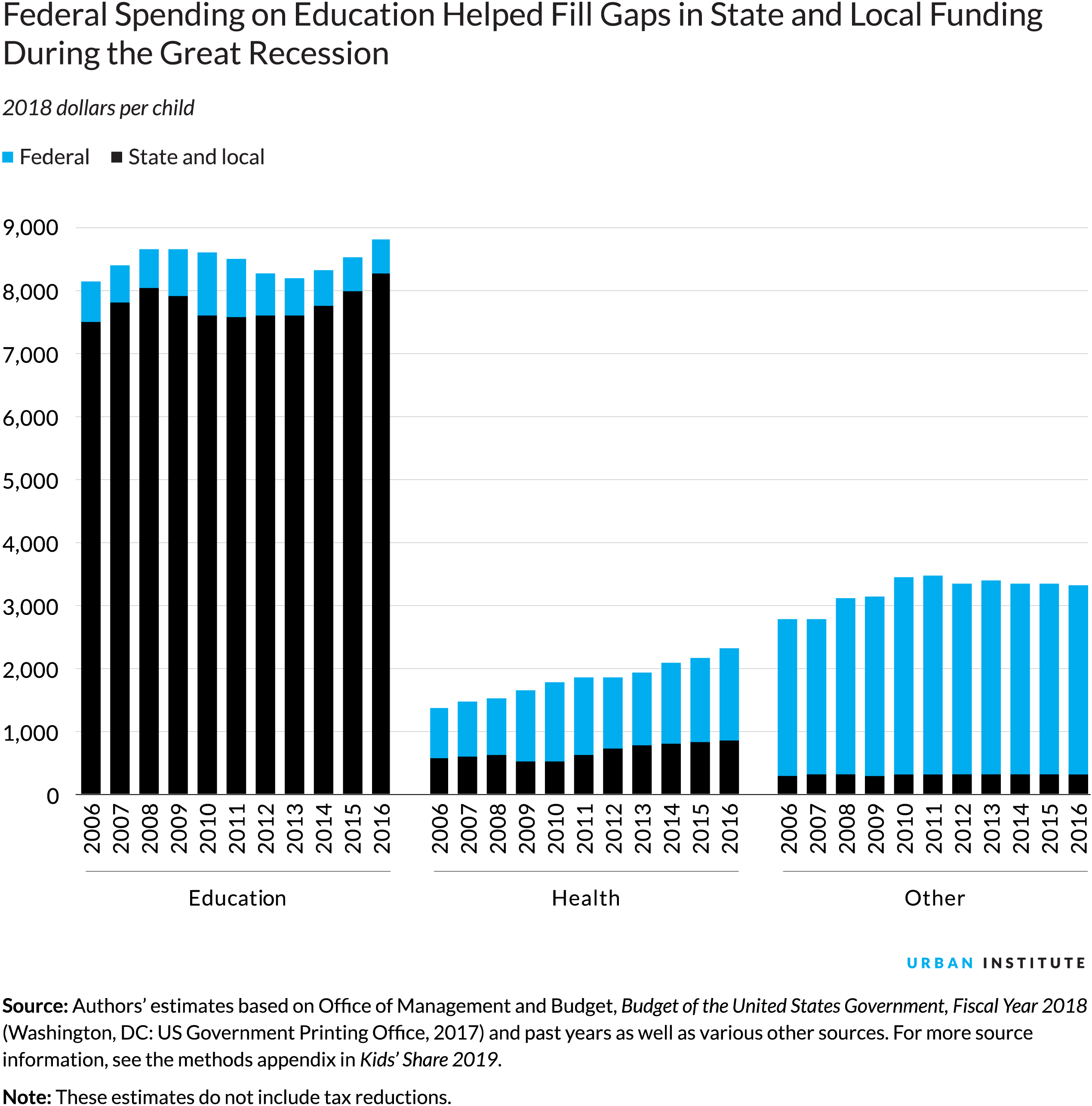
Federal Spending on Education Is Lower Than Other Spending on Kids, but It Is Targeted to Vulnerable Children
Federal spending on elementary and secondary education ($41 billion) made up a small share of total federal spending on children in 2018. The largest categories of federal spending on kids are tax provisions ($178 billion) and health ($116 billion)—areas often associated with adults.
Even though federal spending on elementary and secondary education is lower than other federal spending categories and state and local spending on education, it is largely targeted to ensure equal opportunity for vulnerable children. In 2018, $15 billion in federal spending went to Title I funding for schools with large shares of children from low-income families, and $13 billion went to special education and related services covered by the Individuals with Disabilities Education Act.
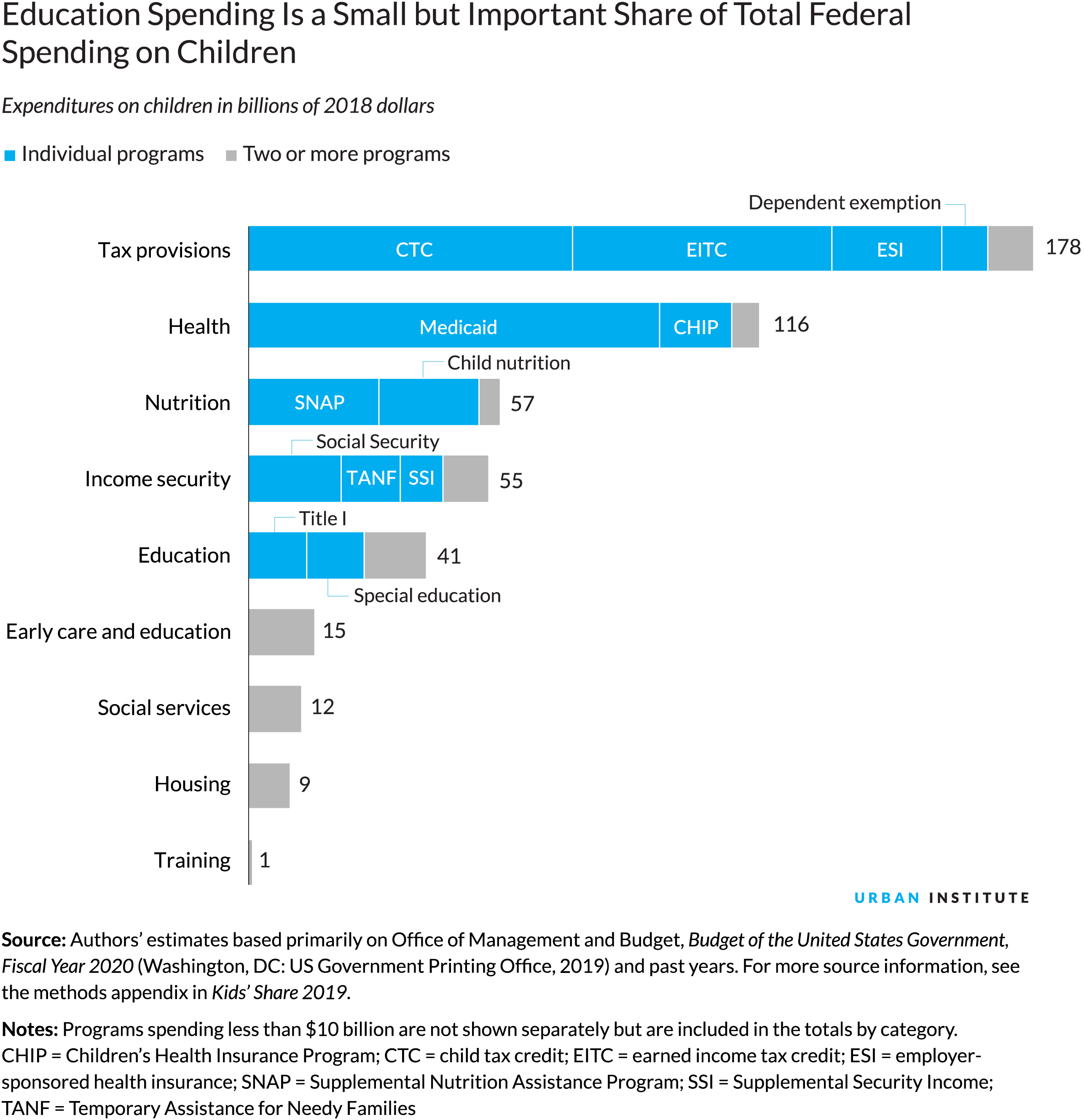
Federal Spending on Education is Shrinking and Projected to Continue Falling
Increased mandatory spending on health programs for children and adults is putting pressure on education spending and other discretionary spending on kids. In 2018, federal spending on education dropped by $1.9 billion. This is part of a long-term trend, as 2018 federal spending on elementary and secondary education was 48 percent below peak spending during the recession (in 2010) and 14 percent below prerecession spending (in 2008).
The forecast for future public spending on education isn’t more optimistic. Federal spending on education programs is projected to fall from $41 billion in 2018 to $36 billion in 2029, accompanied by declines in other discretionary spending programs. Mandatory health spending on children is the only category with strong growth projected over the next decade, which is consistent with long-term trends in all federal health spending.
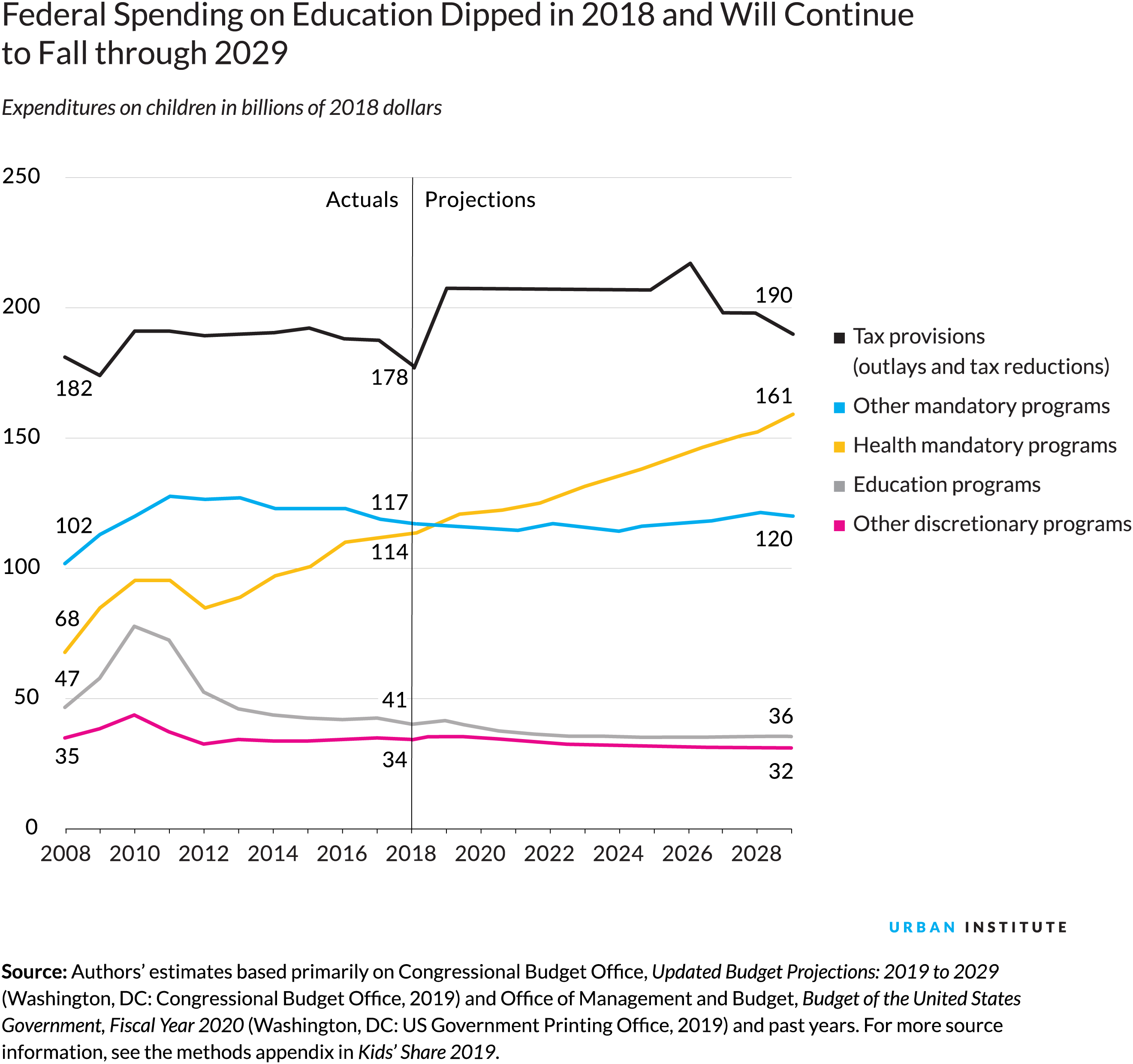
Overall Federal Spending on Children Is Being Squeezed by Automatic Spending Increases for Adult Programs and Interest on the National Debt
It’s not just federal spending on education that’s shrinking. All spending on children made up only 9.2 percent of total federal spending in 2018. That share has been declining in recent years and will fall even further in the next decade, dropping to a projected 7.5 percent in 2029.
Mandatory spending on the adult portions of Social Security, Medicare, and Medicaid will increase because of an aging population expanding the number of beneficiaries as well as overall increases in health care costs. And without more revenue coming in, growth in those programs will also increase interest payments on the national debt. As a result, the share of spending on other priorities that don’t have mandatory increases—including many children’s programs like those in education—will shrink.
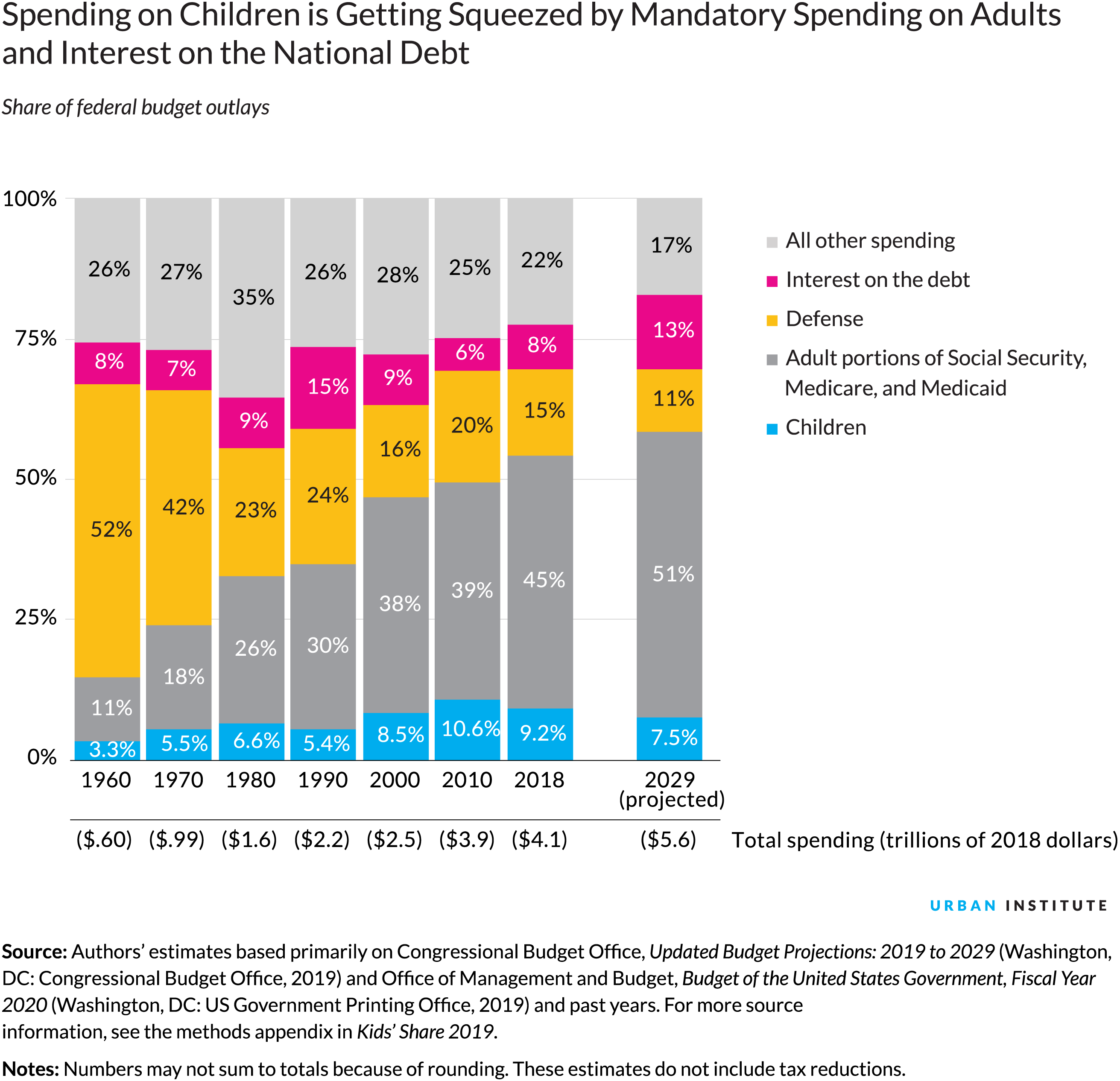
Interest Payments on the National Debt Will Soon Exceed Spending on Children
Federal spending is projected to rise over the next 10 years, and revenues aren’t expected to keep up. As spending exceeds revenues year after year, the national debt will continue to climb. Combined with forecasted higher interest rates, this growing deficit means interest payments on the debt will nearly double by 2029 as a percentage of gross domestic product (and more than double in real dollars).
Despite the rise in overall federal spending as a share of the economy, spending on children is projected to fall over the next decade. Under current policies, interest payments on the debt are projected to exceed spending on children in the next few years.
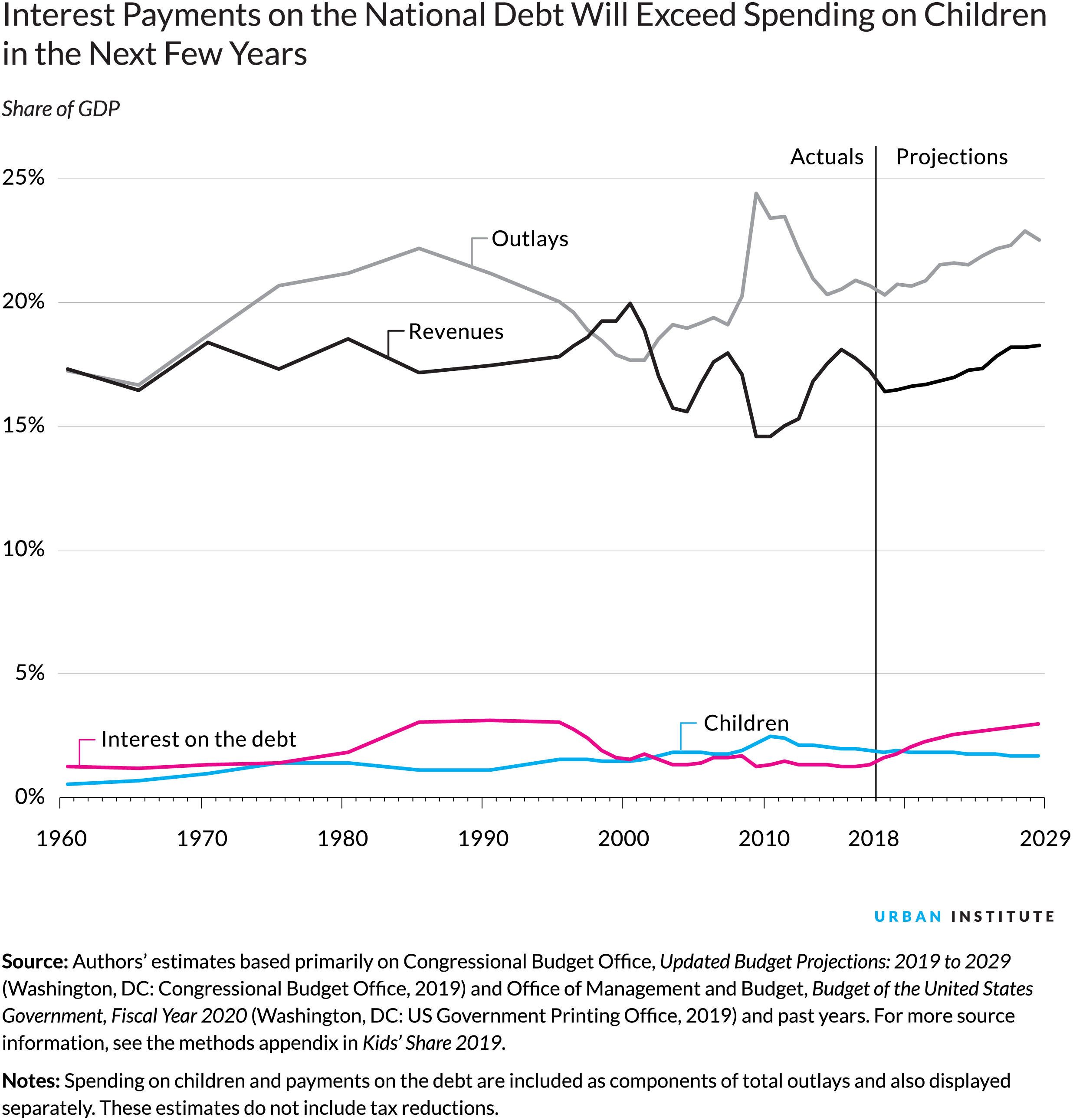
Reexamining Our Approach to Spending on Kids Can Allow Us to Prioritize Future Generations
How our government spends money, and who benefits from that spending, reflects our national priorities. Understanding our current and future investments in children can inform debates on budget, tax, and appropriations legislation and can explain the implications of difficult policy tradeoffs.
Because these projections are based on current law, they aren’t inevitable. Reexamining our federal spending decisions—for education programs and across all categories that benefit kids—can shift our focus to ensure we invest in the success of future generations.
ABOUT THE DATA
For more information, see Kids’ Share 2019: Report on Federal Expenditures on Children through 2018 and Future Projections by Julia B. Isaacs, Cary Lou, Heather Hahn, Eleanor Lauderback, Caleb Quakenbush, and C. Eugene Steuerle. The Kids’ Share annual reportsprovide a comprehensive picture of federal, state, and local expenditures on children and show long-term trends in federal spending, including historical spending from 1960 and projected spending 10 years into the future, assuming no changes to current law.
Spending on higher education, even for children younger than 19, is not included in children’s education spending in Kids’ Share analyses, which focus on elementary and secondary education funding.
PROJECT CREDITS
This feature was funded by the Annie E. Casey Foundation and Peter G. Peterson Foundation. We are grateful to them and to all our funders, who make it possible for Urban to advance its mission. The views expressed are those of the authors and should not be attributed to the Urban Institute, its trustees, or its funders. Funders do not determine research findings or the insights and recommendations of our experts. More information on our funding principles is available here. Read our terms of service here.
RESEARCH Cary Lou, Heather Hahn, Julia B. Isaacs, Eleanor Lauderback, Caleb Quakenbush, and C. Eugene Steuerle
DEVELOPMENT Alice Feng
DESIGN Brittney Spinner
EDITING Liza Hagerman
WRITING Emily Peiffer
Photo by Monkey Business Images/Shutterstock.